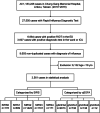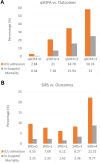Prognostic accuracy of SIRS criteria and qSOFA score for in-hospital mortality among influenza patients in the emergency department
- PMID: 32471385
- PMCID: PMC7256917
- DOI: 10.1186/s12879-020-05102-7
Prognostic accuracy of SIRS criteria and qSOFA score for in-hospital mortality among influenza patients in the emergency department
Abstract
Background: The seasonal influenza epidemic is an important public health issue worldwide. Early predictive identification of patients with potentially worse outcome is important in the emergency department (ED). Similarly as with bacterial infection, influenza can cause sepsis. This study was conducted to investigate the effectiveness of the Systemic Inflammatory Response Syndrome (SIRS) criteria and the quick Sequential Organ Failure Assessment (qSOFA) score as prognostic predictors for ED patients with influenza.
Methods: This single-center, retrospective cohort study investigated data that was retrieved from a hospital-based research database. Adult ED patients (age ≥ 18 at admission) with laboratory-proven influenza from 2010 to 2016 were included for data analysis. The initial SIRS and qSOFA scores were both collected. The primary outcome was the utility of each score in the prediction of in-hospital mortality.
Results: For the study period, 3561 patients met the study inclusion criteria. The overall in-hospital mortality was 2.7% (95 patients). When the qSOFA scores were 0, 1, 2, and 3, the percentages of in-hospital mortality were 0.6, 7.2, 15.9, and 25%, respectively. Accordingly, the odds ratios (ORs) were 7.72, 11.92, and 22.46, respectively. The sensitivity and specificity was 24 and 96.2%, respectively, when the qSOFA score was ≥2. However, the SIRS criteria showed no significant associations with the primary outcome. The area under the receiver operating characteristic curve (AUC) was 0.864, which is significantly higher than that with SIRS, where the AUC was 0.786 (P < 0.01).
Conclusions: The qSOFA score potentially is a useful prognostic predictor for influenza and could be applied in the ED as a risk stratification tool. However, qSOFA may not be a good screening tool for triage because of its poor sensitivity. The SIRS criteria showed poor predictive performance in influenza for mortality as an outcome. Further research is needed to determine the role of these predictive tools in influenza and in other viral infections.
Keywords: “Influenza”; “Mortality”; “Predictors”; “Sirs”; “qSOFA”.
Conflict of interest statement
The authors declare that they have no competing interests.
Figures




Similar articles
-
Low sensitivity of qSOFA, SIRS criteria and sepsis definition to identify infected patients at risk of complication in the prehospital setting and at the emergency department triage.Scand J Trauma Resusc Emerg Med. 2017 Nov 3;25(1):108. doi: 10.1186/s13049-017-0449-y. Scand J Trauma Resusc Emerg Med. 2017. PMID: 29100549 Free PMC article.
-
The Combined SIRS + qSOFA (qSIRS) Score is More Accurate Than qSOFA Alone in Predicting Mortality in Patients with Surgical Sepsis in an LMIC Emergency Department.World J Surg. 2020 Jan;44(1):21-29. doi: 10.1007/s00268-019-05181-x. World J Surg. 2020. PMID: 31641836
-
Systemic Inflammatory Response Syndrome, Quick Sequential Organ Function Assessment, and Organ Dysfunction: Insights From a Prospective Database of ED Patients With Infection.Chest. 2017 Mar;151(3):586-596. doi: 10.1016/j.chest.2016.10.057. Epub 2016 Nov 19. Chest. 2017. PMID: 27876592
-
Head-to-head comparison of qSOFA and SIRS criteria in predicting the mortality of infected patients in the emergency department: a meta-analysis.Scand J Trauma Resusc Emerg Med. 2018 Jul 11;26(1):56. doi: 10.1186/s13049-018-0527-9. Scand J Trauma Resusc Emerg Med. 2018. PMID: 29996880 Free PMC article. Review.
-
Accuracy of quick Sequential Organ Failure Assessment (qSOFA) score and systemic inflammatory response syndrome (SIRS) criteria for predicting mortality in hospitalized patients with suspected infection: a meta-analysis of observational studies.Clin Microbiol Infect. 2018 Nov;24(11):1123-1129. doi: 10.1016/j.cmi.2018.03.032. Epub 2018 Mar 29. Clin Microbiol Infect. 2018. PMID: 29605565
Cited by
-
Two-stage prediction model for in-hospital mortality of patients with influenza infection.BMC Infect Dis. 2021 May 19;21(1):451. doi: 10.1186/s12879-021-06169-6. BMC Infect Dis. 2021. PMID: 34011298 Free PMC article.
-
Viral co-detection of influenza virus and other respiratory viruses in hospitalized Brazilian patients during the first three years of the coronavirus disease (COVID)-19 pandemic: an epidemiological profile.Front Microbiol. 2024 Oct 16;15:1462802. doi: 10.3389/fmicb.2024.1462802. eCollection 2024. Front Microbiol. 2024. PMID: 39479210 Free PMC article.
-
Influenza A infections: predictors of disease severity.Braz J Microbiol. 2024 Mar;55(1):75-86. doi: 10.1007/s42770-023-01186-w. Epub 2023 Dec 5. Braz J Microbiol. 2024. PMID: 38049661 Free PMC article.
-
Unmanaged Diabetes and Elevated Blood Glucose Are Poor Prognostic Factors in the Severity and Recovery Time in Predominantly Hispanic Hospitalized COVID-19 Patients.Front Endocrinol (Lausanne). 2022 Jul 8;13:861385. doi: 10.3389/fendo.2022.861385. eCollection 2022. Front Endocrinol (Lausanne). 2022. PMID: 35898451 Free PMC article. No abstract available.
-
A systematic review of tools for predicting complications in patients with influenza-like illness.Heliyon. 2023 Dec 3;10(1):e23227. doi: 10.1016/j.heliyon.2023.e23227. eCollection 2024 Jan 15. Heliyon. 2023. PMID: 38163091 Free PMC article. Review.
References
-
- Cox NJ, Subbarao K. Global epidemiology of influenza: past and present. Annu Rev Med. 2000;51:407–421. - PubMed
-
- Harper SA, Bradley JS, Englund JA, File TM, Gravenstein S, Hayden FG, et al. Seasonal influenza in adults and children--diagnosis, treatment, chemoprophylaxis, and institutional outbreak management: clinical practice guidelines of the Infectious Diseases Society of America. Clin Infect Dis. 2009;48:1003–1032. - PMC - PubMed
-
- World Health Organization. Pandemic (H1N1) 2009 - update 112. https://www.who.int/csr/don/2010_08_06/en. Accessed 30th Aug 2017.
MeSH terms
Grants and funding
LinkOut - more resources
Full Text Sources
Medical
Miscellaneous

